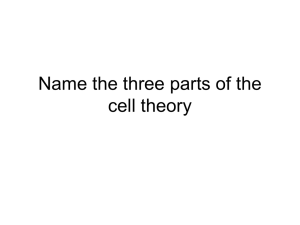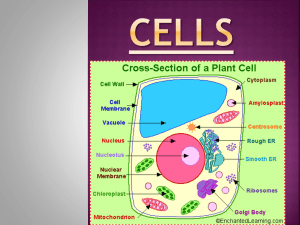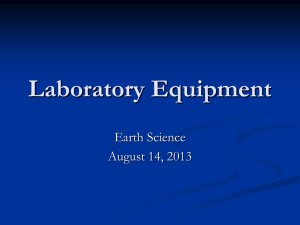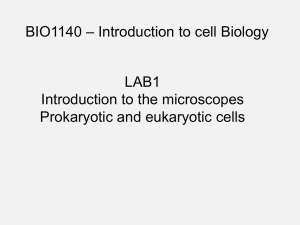The discovery of the cellular basis of living things
advertisement
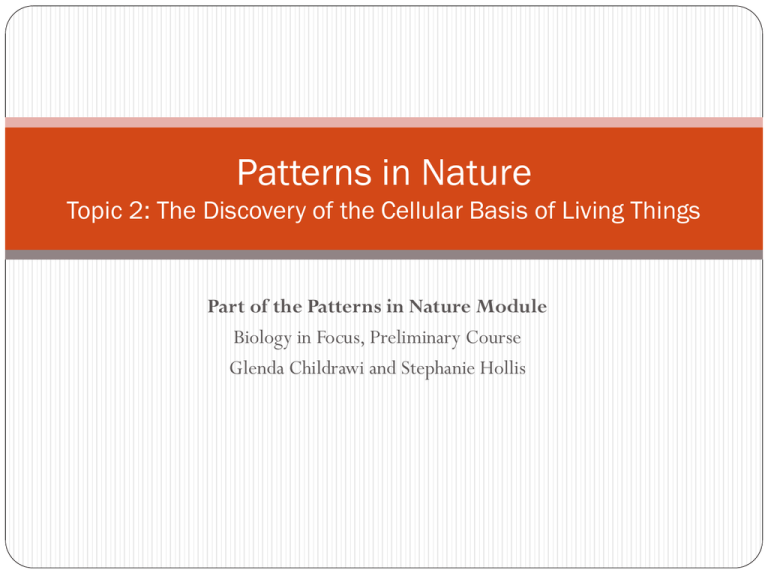
Patterns in Nature Topic 2: The Discovery of the Cellular Basis of Living Things Part of the Patterns in Nature Module Biology in Focus, Preliminary Course Glenda Childrawi and Stephanie Hollis Dot Point Outline the historical development of the cell theory, in particular, the contributions of Robert Hooke and Robert Brown kyrene.org anbg.gov.au Introduction The statement that all living things are made of cells forms the basis of what is currently known as ‘The Cell Theory’. The historical development of the cell theory is interwoven with the story of the invention and development of the microscope. thebloodconnection.org Introduction Improvements in the design and use of microscopes as well as progress in techniques to prepare specimens for viewing have played a significant part in advancing our knowledge and understanding of cells. neato.me Introduction In order to better understand where we are at today with our understanding of life and cells, we must first look at the historical developments in this area. nobelprize.org Biological View Prior to the Cell Theory Until the last decade of the 16th century (1590), microscopes did not exists, cells had never been seen and so the living world had not been considered at a cellular level. philadelphia.about.com Biological View Prior to the Cell Theory One accepted view at this time was the theory of spontaneous generation. This theory predicted that living creatures could arise from inanimate (non-living) material. kangaroo-protection-coalition.com This theory is based on observation. For example, maggots ‘appeared’ on rotting meat if it was left exposed for a period of time. Biological View Prior to the Cell Theory This theory was challenged in the 1500’s but it wasn’t until 1688 (nearly 2000 years later) that scientists suggested that the flies that visited the meat contributed to the appearance of maggots. ayerhome.co.za This is one of the first recorded examples of experimentation being used to oppose a theory. (an example of the scientific method) The Invention of the compound microscope In the late 1500’s, scientists, who were using poor quality magnifying glasses to view small objects tried many things to improve the images that they were viewing. 3dconceptualdesigner.blogspot.com The Invention of the compound microscope This led to the invention of the first compound microscope. To get a larger and clearer image, two convex lenses could be placed above one another. The lower lens would produce a magnified image and the upper lens would further magnify that image. gloryprakash4-vibgyor.blogspot.com The Invention of the compound microscope Two Dutch lens makers Hans and Zacharias Janssen made the first compound microscope in 1590. It was made of two convex lenses placed at either end of a wooden tube. This could magnify objects 3 to 9 times! olympusmicro.com Technological Improvements to the compound microscope From there, these instruments were refined and improved upon. By the early 1600’s most microscopes in use had a magnification of about 30x. sciencemuseum.org.uk Robert Hooke in England, Anton van Leeuwenhoek in Holland and Galileo Galilei in Italy all made noted contributions to improving the design of microscopes Technological Improvements to the compound microscope In the 17th century Robert Hooke created a compound microscope that was progressive for its time. It had a fine adjustment and a light source! bicycle2011.com The light source was a another lens that concentrated the light from a candle onto the specimen! Biological View: Understanding living things using a microscope In 1665 Robert Hooke wrote a book, the first recorded publication to describe observations of living tissue using a microscope: Micrographia: physiological studies of minute bodies made by magnifying glasses ffden-2.phys.uaf.edu Biological View: Understanding living things using a microscope It was in this book that he used the term ‘cell’ to describe the ‘honeycomb’ elements of cork. nlm.nih.gov He was looking at dead plant cells which had no contents and would have clearly resembled small compartments. His findings were respected but not universally accepted at the time. Biological View: Understanding living things using a microscope Anton Van Leeuwnehoek was a Dutch lens maker and was able to produce much higher quality lenses than others. He developed a simple microscope that used a single lens that could magnify up to 300x findingdulcinea.com Van Leeuwenhoek is credited with discovering bacteria and from his written descriptions may have even seen nuclei! Biological View: Understanding living things using a microscope Robert Brown is known for his discovery of the cell nucleus. He discovered that nuclei were present in a wide variety of plant tissue he studied. gesneriads.ca At the time, he had no idea of the importance of this. Biological View: Understanding living things using a microscope In 1883 over a cup of coffee, two German scientists Theodor Schwann and Matthias Schleiden were discussing the results of their microscopic studies of living things. merke.ch Biological View: Understanding living things using a microscope As Schleiden described the regular placement of nuclei he had observed in plant cells, Schwann recognised a similarity to the animal cells he had been studying. It was the first time that a common basic structure for all living things had become evident! Biological View: Understanding living things using a microscope A year later (1839) Schwann published a book on plant and animal cells, listing three main conclusions, two of which are still accepted today as the basis for the cell theory: 1. The cell is the unit of structure of all living things 2. The cell exists as a distinct entity and as a building block in the construction of organisms. 3. Cells for by free-cell formation, similar to the formation of crystals. His third conclusion is not valid Biological View: Understanding living things using a microscope In 1855 Rudolf Virchow’s studies led to the statement that ‘where a cell arises, there a cell must have previously existed.’ From this arose the third statement of the cell theory: All cells come from pre-existing cells. findabout.net Collaboration in science: the importance of the contributions of Hooke and Brown The basic cell theory is today attributed to both Schleiden and Schwann but without the work of Hooke and Brown, these two could not have built their cell theory. Collaboration in science: the importance of the contributions of Hooke and Brown The cellular basis of life was a major breakthrough in biological thinking and led not only to further studies of cells, but also to a cell based theory of disease. healthmatters2day.blogspot.com Homework Answer the following questions in your notebook. Be prepared to discuss next lesson. Explain how two areas of evidence supports the cell theory Identify two technological advancements which led to advancement in the cell theory. Use an example for each advancement
